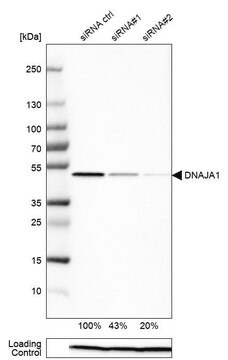E1036
116-9e
≥98% (HPLC), powder
Sinonimo/i:
116-9e, 4-[1,1′-Biphenyl]-4-yl-3,4-dihydro-6-methyl-2-oxo-5-[(phenylmethoxy)carbonyl]-1(2H)-pyrimidinehexanoic acid
About This Item
Prodotti consigliati
Saggio
≥98% (HPLC)
Forma fisica
powder
Colore
white to off-white
Solubilità
DMSO: >20 mg/mL
Temperatura di conservazione
2-8°C
Stringa SMILE
CC1=C(C(NC(=O)N1CCCCCC(O)=O)c2ccc(cc2)-c3ccccc3)C(=O)OCc4ccccc4
InChI
1S/C31H32N2O5/c1-22-28(30(36)38-21-23-11-5-2-6-12-23)29(32-31(37)33(22)20-10-4-9-15-27(34)35)26-18-16-25(17-19-26)24-13-7-3-8-14-24/h2-3,5-8,11-14,16-19,29H,4,9-10,15,20-21H2,1H3,(H,32,37)(H,34,35)
GHFQWLNXJMUCGC-UHFFFAOYSA-N
Applicazioni
Azioni biochim/fisiol
The same compound by a different name, MAL2-11B, has been found to inhibit the activity of a viral J-domain protein, large tumor antigen (TAg). MAL2-11B inhibited both TAg′s endogenous ATPase activity and the TAg-mediated activation of Hsp70.
Avvertenze
Danger
Indicazioni di pericolo
Consigli di prudenza
Classi di pericolo
Acute Tox. 3 Oral - Aquatic Acute 1 - Aquatic Chronic 1
Codice della classe di stoccaggio
6.1C - Combustible, acute toxic Cat.3 / toxic compounds or compounds which causing chronic effects
Classe di pericolosità dell'acqua (WGK)
WGK 3
Punto d’infiammabilità (°F)
Not applicable
Punto d’infiammabilità (°C)
Not applicable
Certificati d'analisi (COA)
Cerca il Certificati d'analisi (COA) digitando il numero di lotto/batch corrispondente. I numeri di lotto o di batch sono stampati sull'etichetta dei prodotti dopo la parola ‘Lotto’ o ‘Batch’.
Possiedi già questo prodotto?
I documenti relativi ai prodotti acquistati recentemente sono disponibili nell’Archivio dei documenti.
Il team dei nostri ricercatori vanta grande esperienza in tutte le aree della ricerca quali Life Science, scienza dei materiali, sintesi chimica, cromatografia, discipline analitiche, ecc..
Contatta l'Assistenza Tecnica.








